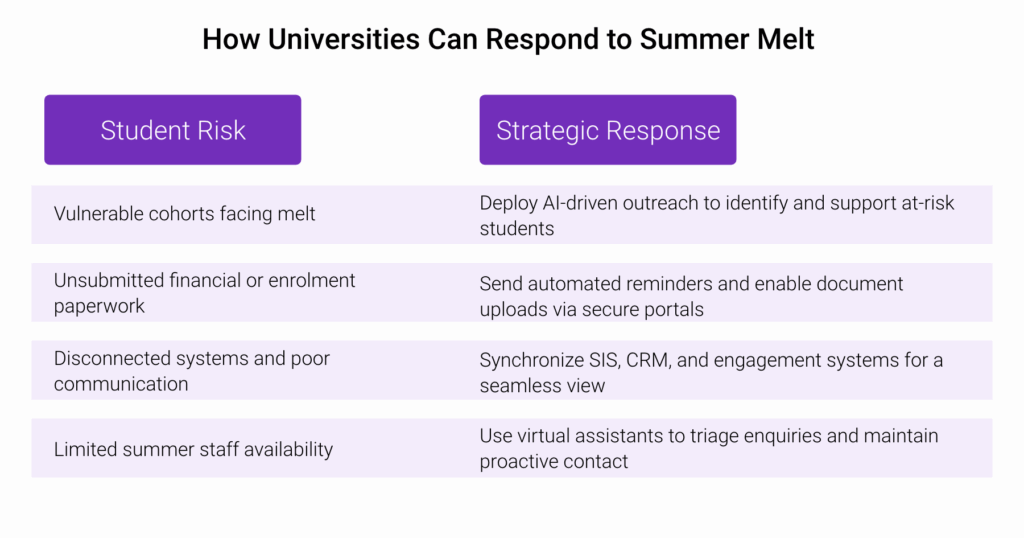How UK Clearing and the US summer break define key moments for institutional planning.
When summer arrives, UK admissions teams brace for one of their most intense seasons: UCAS Clearing. In 2023, a record 38,140 UK 18‑year‑olds secured university places through Clearing (a 14.6% increase from the previous year), triggering a flood of enquiries, rapid decision making, and institutional strain.
Across the Atlantic, US universities battle a different kind of pressure between May and August, known as “summer melt”. Research shows that 10-20% of college-intending students in the US never show up for the first day of classes, often due to financial hurdles, administrative delays, or waning engagement.
Despite their different calendars, both summer periods bring a common tension: scarce staff capacity, heightened expectations, and rising volumes of data and interaction at a time when resources are stretched thin.
This is more than just a seasonal challenge. It’s a turning point. And across both systems, institutions are rethinking how they use this time, deploying smarter, data driven strategies to move from survival to advantage. Ahead, we explore how UK teams can manage the Clearing crunch, how US planners can prepare for fall, and what the future of summer strategy could look like for higher education.
The UK Perspective: Navigating the New Clearing Reality
Clearing has long tested institutional capacity. But lately, it has evolved into something more: a deliberate, strategic pathway for tens of thousands of students. With more than 50,000 placed through UCAS Clearing each year, it now stands as one of the most critical admissions windows in the UK calendar.
Today’s applicants are digitally fluent, with many using tools like “decline my place” to reconfigure their decisions in real time. For universities, that means responding faster, across more channels, and with greater clarity, all without overextending already stretched teams.
Operational challenges include:
- High-volume applicant triage under pressing timelines
- Eligibility checks and document validation bottlenecks
- Spike in enquiries from prospective students
- Strain on CRM systems, call centers, websites, and support infrastructure
Clearing is no longer just about catching up. It’s about getting ahead by making faster, smarter, and more connected decisions when every moment counts. And by adapting to these rapidly evolving scenarios, many institutions can transform how they manage peak-season admissions on the ground.

Adopting these approaches can help teams reduce admin strain, improve response times, and operate more confidently during the high-pressure weeks of Clearing.
The US Perspective: Understanding & Tackling Summer Melt
“Summer melt” has become more than a campus catchphrase. It reveals deep gaps in student support and enrolment processes. While 10–20% of college-intending students may not enroll, the figure rises to up to 40% among low-income, first-generation, or community-college-bound students.
This elevated risk highlights why summer matters:
- Processes go dark: Enrolment checks, financial paperwork, and student outreach often slow down once classes end.
- Uncertainty increases: Students face deadlines and stress over finances, housing, and registration during a time of limited institutional support.
- Cohort diversity suffers: Vulnerable students are more likely to disengage, lowering retention and equity goals before term even begins.
Operational pain points during the US summer cycle often emerge in the spaces where urgency meets silence. Financial aid teams are inundated with last-minute paperwork and appeals. Registration systems face delays in confirming housing, course loads, and enrolment status. Communication channels often spread across departments—can leave at-risk students without timely answers. And without a unified view, universities struggle to distinguish who’s truly on track from those quietly drifting away.

By addressing these summer melt challenges with clear, data-driven interventions, universities can significantly boost enrolment rates, improve diversity outcomes, and treat summer as a strategic bridge rather than a silent season.
From Strain to Strategy: FAQs on How FD Ryze Supports Higher Education
Admissions doesn’t pause for operational strain. Whether you’re scaling for Clearing, planning for fall, or simply trying to keep students from slipping through the cracks, FD Ryze meets the moment.
What is FD Ryze, and why is it a good fit for universities?
FD Ryze is Fulcrum Digital’s Agentic AI platform, built for institutions navigating high-stakes, high-volume academic operations. It integrates into your existing systems, such as UCAS, SIS, CRM, or financial aid platforms, and enhances them with modular AI agents that automate tasks, improve visibility, and reduce staff strain. It’s designed to work the way higher education works: seasonal, deadline-driven, and deeply human.
How can FD Ryze streamline university admissions workflows?
FD Ryze uses AI-powered agents to triage applications, validate documents, and flag issues like missing transcripts or eligibility gaps. This accelerates decision-making during UK Clearing and supports onboarding workflows during the final weeks of US summer admissions.
What role do virtual assistants play in student engagement?
FD Ryze’s virtual assistants manage high volumes of FAQs and routine queries, freeing up staff while ensuring that students stay informed. During UK Clearing, they help reduce pressure on call centers. In the US, they offer continuity of contact throughout the summer melt window.
How can FD Ryze reduce the risk of summer melt or applicant drop-off?
Through proactive nudging, FD Ryze identifies students who are at risk of disengaging, particularly in underserved or first-gen cohorts. Automated reminders, personalized messages, and predictive signals help universities take action before the student falls off the radar.
How does FD Ryze support better data coordination across departments?
FD Ryze functions as an orchestration layer, integrating UCAS data, SIS records, CRM activity, and financial aid inputs into one accessible dashboard. This provides admissions teams and planners with real-time insight into where students stand, what’s missing, and what’s urgent.
Can FD Ryze help universities prepare for high-traffic periods like Results Day?
Yes. FD Ryze supports infrastructure scaling, load testing, and traffic pattern forecasting, minimizing digital bottlenecks during peak events like UCAS Results Day or late-stage US course registration surges. It ensures your systems stay responsive when it matters most.
Every institution has its own pace, pressures, and priorities. The real opportunity lies in finding technology that doesn’t just respond to those realities but respects them.
Want to explore how FD Ryze could support your institution? Let’s start the conversation.







